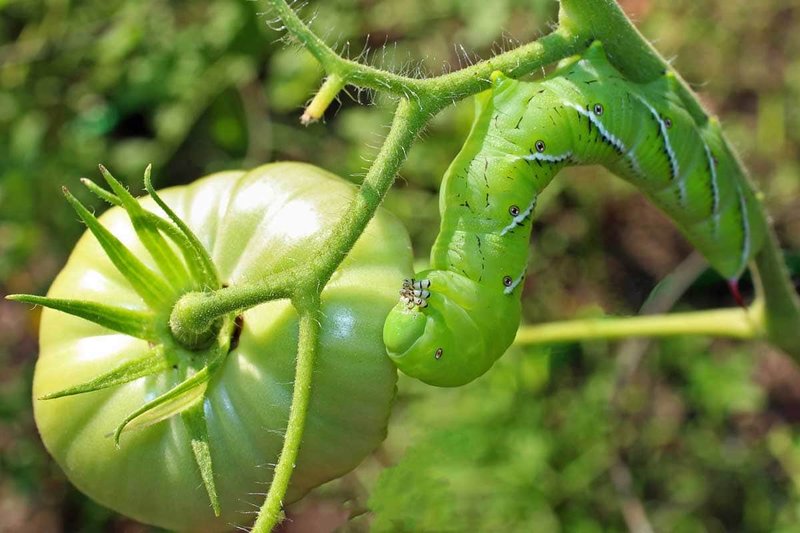
Think of tomato plants as a buffet for these hulking caterpillars. They’re drawn to many things, which we’ll discuss in a bit. It’s not just a random craving; there are specific factors drawing them in. Knowing what attracts hornworms can help you better protect your plants and keep your garden thriving.
Now, instead of just sitting in worry, let’s figure this out together. By the end of this article, you’ll have a better grasp of these pesky critters so you can keep your tomatoes healthy and happy.
Understanding Hornworms and Their Preferences
Hornworms are the larvae of moths, specifically the Five-spotted Hawk Moth. When these little caterpillars emerge, they’re on a mission to find their favorite food: tomato plants. They’re not picky eaters, but tomatoes are like a gourmet meal for them, and here’s why:
- Nutrient-rich foliage: Tomato leaves are packed with nutrients that hornworms crave.
- Fresh growth: Young, tender plants are particularly attractive because they’re easier for hornworms to eat.
- Fragrance: Tomato plants emit a smell that’s irresistible to hornworms, luring them in for a feast.
You might be wondering, “What do they look like?” These caterpillars can grow quite large—up to 4 inches long—often with a distinctive horn at their rear end, which is how they get their name. So, spotting them isn’t usually hard, but by the time you see them, they may have already done some damage.
The Role of Weather and Environment
The weather plays a significant role in attracting hornworms to your garden. Warm, humid environments are their playgrounds. This is an important factor, especially in the summer months. Here’s how the environment affects their appearance:
- Temperature: Hornworms thrive in temperatures between 70°F and 85°F. If you notice these temperatures in your area, expect them to show up.
- Moisture: High humidity levels create ideal conditions for both tomatoes and hornworms. The moisture helps the plants grow lush leaves, which are a favorite for these pests.
- Nearby plants: If you have nearby crops like peppers or eggplants, hornworms may be attracted to your tomato plants as they often feed on these plants too.
Just imagine your garden as a party. If it’s warm and inviting, you’ll receive more than just your friends. Unfortunately, hornworms show up with their party hats ready to munch on your plants.
Attractants and Garden Practices
Some gardening practices can inadvertently make your tomato plants more appealing to hornworms. Here are a few key factors:
- Over-fertilizing: Using too much fertilizer can lead to lush plant growth, making your tomatoes even more attractive to hornworms.
- Not rotating crops: If you plant tomatoes in the same spot year after year, hornworms will find their way back more easily.
- Weak plants: Plants that are stressed or unhealthy may attract hornworms as they look for weaker foliage to munch on.
It’s like setting up a neon sign that says, “Welcome, hornworms!” By being mindful of how you care for your plants, you can reduce the risk of these pests taking over.
Attracting Beneficial Insects
Interestingly, not all visitors to your garden are pests. There are also beneficial insects that can help control hornworm populations naturally. Here’s how you can attract these helpers:
- Plant diversity: Including a variety of plants can attract natural predators like ladybugs and parasitic wasps that feed on hornworms.
- Provide shelter: Creating hiding spots for beneficial insects by using rocks, brush piles, or flower beds can encourage them to stick around.
- Avoid pesticides: Chemical treatments can kill beneficial insects alongside the hornworms. Opt for natural pest control methods instead.
Think of it this way—by inviting the right guests to your garden party, you can create a more balanced ecosystem that keeps hornworms at bay.
Signs of Hornworm Infestation
So, how do you know if hornworms are invading your tomato plants? Here are some telltale signs:
- Holes in leaves: Look for irregular holes in the foliage, especially on younger leaves where hornworms prefer to feed.
- Frass: You might notice small droppings (called frass) near the base of the plants, a sure sign of feeding activity.
- Presence of caterpillars: Of course, spotting the hornworms themselves is the most obvious sign. They’re large and can blend in well due to their green color.
Always keep a close eye on your plants. Catching these pests early can make all the difference in protecting your harvest.
Effective Control and Prevention Methods
If you find that hornworms have set up camp in your garden, don’t fret. There are ways to control them and prevent future invasions:
- Hand-picking: The old-fashioned method of picking hornworms off by hand can be effective, especially if your garden isn’t too large.
- Neem oil: This natural pesticide disrupts hornworm feeding without harming beneficial insects. Spray it directly on affected areas.
- Introduce beneficial insects: As mentioned, ladybugs and wasps can help keep hornworm populations in check.
It’s much like playing defense in sports—stopping hornworms before they can do too much damage is key to a successful growing season.
Wrapping It Up: Keeping Your Tomato Plants Safe
Noticing hornworms on your tomato plants can be frustrating, but understanding what attracts them is the first step in keeping your garden secure. By making your plants less appealing and encouraging beneficial insects, you can create a more balanced gardening environment.
Remember, tomatoes can be a delicious addition to your meals, but they also attract some unwelcome guests. By staying vigilant, you can protect your plants and enjoy the fruits of your labor. Happy gardening!

